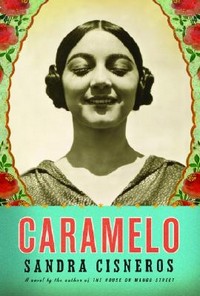Reading Caramelo was an odd experience. I used a library copy, but the only one my library had was the large print edition. The large type gave the odd impression of being shouted at. At first, I thought the larger print was the reason it was taking me a long time (several days) to read through this deceptively simple text.
But that’s the thing. Cisnero’s novel, like her earlier work The House on Mango Street, is not a simple narrative. In fact, it’s not really plot driven. It’s a series of interconnected moments, told with rich detail and, at times, overwhelming emotion. The narrator, Lala or Celaya Reyes, tells the story of three generations of her family’s history in Mexico City, Chicago and San Antonio. Yet we’re constantly reminded throughout the text that this isn’t entirely a fiction as Cisneros weave her own family’s, U.S. and Mexican histories into the book’s footnotes, using the device of the novel to fill in gaps in the historical record.
The narrative device is a candy colored (caramelo) rebozo, left unfinished by the too-young death of Celaya’s great grandmother, the Awful Grandmother’s mother. It fascinates Lala from the time she is a small child until she inherits it as a young teenager. Like her grandmother, for whom she has little affection, she braids and unbraids the unfinished threads of the scarf. Likewise the narrative feels incomplete as Lala tries to piece together her family’s stories from what they tell her, what they haven’t told her and from her own creative imaginings.
Reading some of the reviews on Amazon, you would think that the book is written in Spanish as much as English. This isn’t the case — there’s no Spanish in the text that can’t be translated by context. However, in a sense those reviews are right. The English names “Aunty Light Skin” or “Uncle Baby,” “The Little Grandfather” are badly or literally translated Spanish, highlighting the impossibility of translating an endearment from Spanish into English without loss. It is, I believe, a clever way of the author joking with the bilingual reader, pointing out that something will always be lost in the move from Mexico to the United States.
[Passing note: I don’t see this book working for the class on the Chicana/o Gothic I’m constructing. Mores the pity because it is a lovely novel.]
